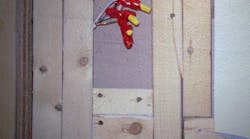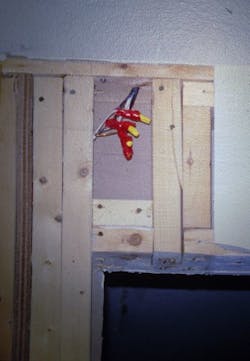How well do you know the Code? Think you can spot violations the original installer either ignored or couldn't identify? Here's your chance to moonlight as an electrical inspector and second-guess someone else's work from the safety of your living room or office. It's your turn to identify the violation.
Hint: Floating free
Find the Answer
My customer uncovered this surprise while performing a renovation on his house. The hollow space between the studs was being used as a splice box. Generally, whenever splices or junctions are made — or an outlet, switch, termination point, or pull point is installed — a real box must be installed in accordance with 300.15.
For temporary wiring on construction sites, Sec. 590.4(J) permits splices or junctions to be made in multiconductor cord or cable type wiring methods without the use of a box, provided however, the continuity of the equipment grounding conductor is maintained even without the use of a box. While this area could be defined as a construction site, the splices we found in the walls were in no way part of a temporary wiring arrangement. This was permanent wiring for the house that was simply buried in the wall. There are some other installations described in 300.15(A) through (L) that would not require the use of a box, however, none of those sections are applicable to this situation.





